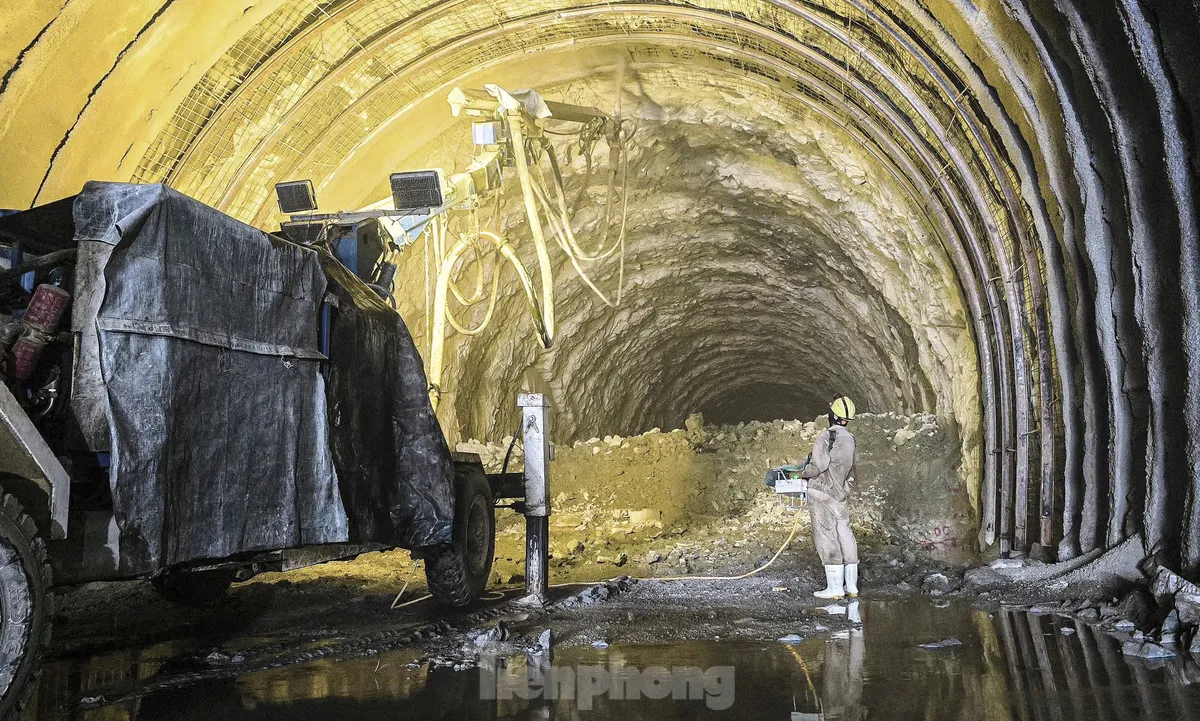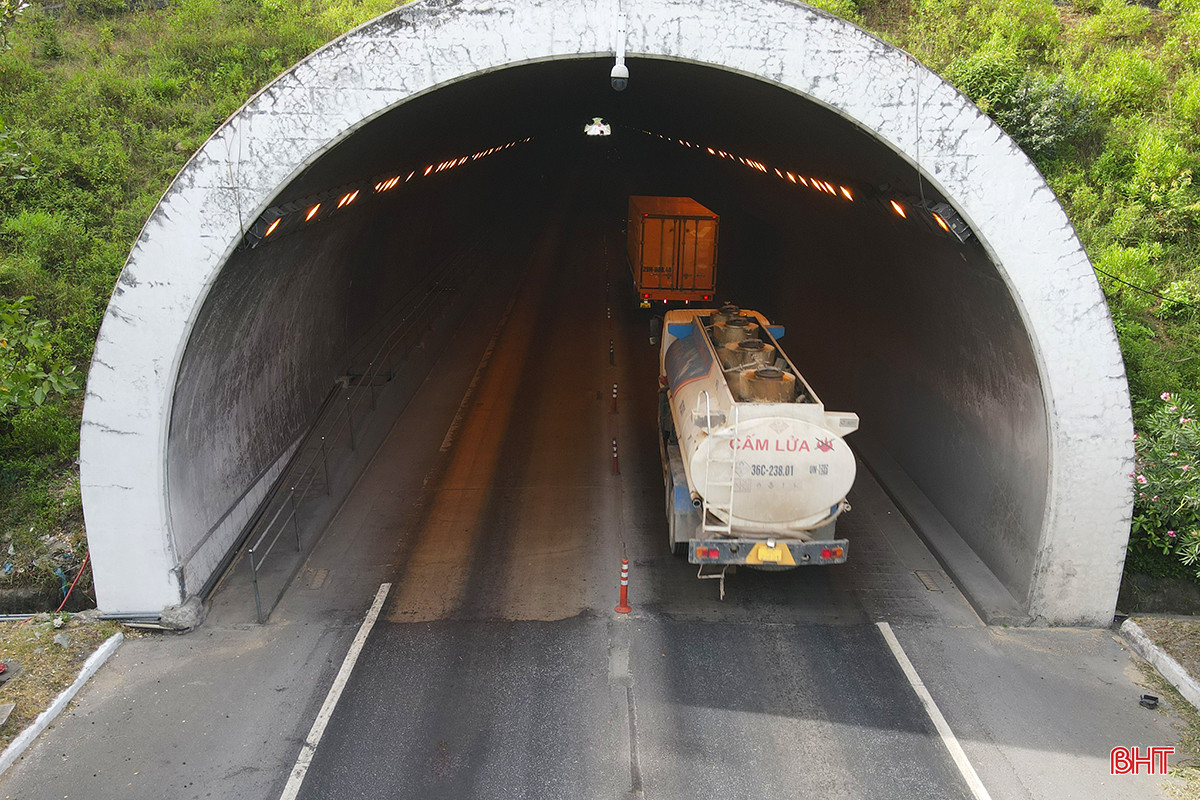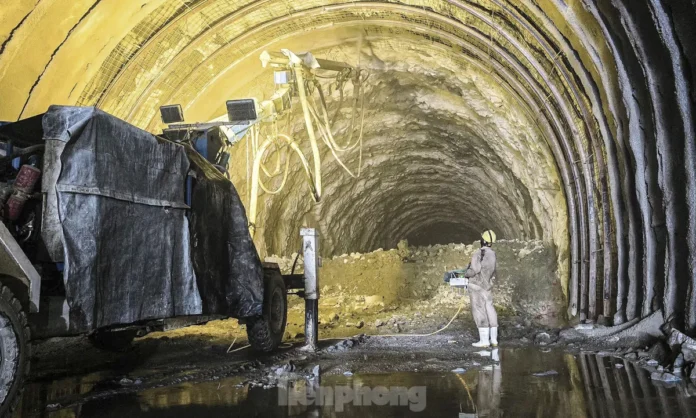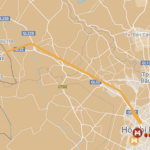Boost from a Nearly VND 2,000 Billion Project
The expansion of Deo Ngang Tunnel, a strategic transportation route on National Highway 1A, is being expedited with a target completion date of 2025. Beyond alleviating the ever-increasing traffic pressure, the project holds the promise of boosting socio-economic development and enhancing national defense and security in the North Central region.
Part of the master plan approved by the Ministry of Transport (now the Ministry of Construction) to upgrade key tunnels and bridges along National Highway 1 at a cost of VND 2,000 billion, the Deo Ngang Tunnel expansion project includes a new tunnel tube measuring 555 meters in length and 10.5 meters in width, accommodating four traffic lanes, along with over 2.3 kilometers of synchronized approach roads.

The tunnel construction is supported by state-of-the-art equipment, including drilling rigs, tunnel boring robots, concrete pumps, and dust extraction systems. Image: TPO
Upon completion, the two tunnel tubes, the original and the new one, will operate in parallel, providing a total road width of 20.5 meters with four motorized lanes and two mixed-use lanes. The expected increase in speed to 80 km/h, one and a half times the current speed limit, will reduce travel time and the risk of congestion and accidents in this treacherous mountain pass.
Once operational, the expanded Deo Ngang Tunnel is expected to significantly contribute to:
- Relieving traffic congestion on National Highway 1 between Ha Tinh and Quang Binh provinces, which frequently experiences gridlock during peak hours and holidays.
- Enhancing road safety in this hazardous mountainous area, which has been the site of numerous serious accidents.
- Improving regional connectivity and creating an efficient transport corridor for the provinces of North Central Vietnam and the South Central Coast.
- Boosting socio-economic development, particularly in the fields of logistics, trade, and tourism.
- Strengthening national defense and security by ensuring smooth connections between strategic coastal areas in Central Vietnam.
Expedited Construction Amid Geologic and Weather Challenges
As of early June, the tunnel construction site is operating around the clock with three shifts per day. On the north side (Ha Tinh province), the contractor has excavated over 150 meters, while on the south side (Quang Binh province), they have reached 50 meters. State-of-the-art equipment, including tunnel boring robots, drilling rigs, concrete pumps, and dust extraction systems, is being utilized to ensure progress and worker safety.
Mr. Cuong, a construction worker, shared, “Although we are spared from the scorching sun while working in the tunnel, the dusty and stuffy air means we always have to wear full protective gear. Each shift involves close coordination between technicians, machine operators, and safety personnel.”

The Deo Ngang Tunnel is currently operating with one tube accommodating two motorized lanes and two mixed-use lanes. Image: Ha Tinh Newspaper
Engineer Lam Van Truong, the project commander, told Tien Phong newspaper that the construction team aims to break through the tunnel by mid-July. However, significant challenges remain, including complex geology and delays in land handover, especially on the south side due to issues with relocating residential areas and ensuring road safety corridors.
Located on the border between Ha Tinh and Quang Binh, the two provinces with the narrowest east-west widths in Vietnam, with averages of 60-70 kilometers and 40.3 kilometers, respectively, the Deo Ngang Tunnel faces unique geographic challenges due to the mountainous terrain and harsh climate. As such, the expansion of this mountain-piercing tunnel is a breakthrough initiative.
Thus, the Deo Ngang Tunnel expansion project is more than just a transportation infrastructure development; it symbolizes the determination to invest in strategic infrastructure to foster sustainable development in the entire region.
The project is expected to be completed and put into operation by the end of 2025, marking a new milestone in the ongoing efforts to enhance the vital transportation network along Vietnam’s central coastline.
The First Vietnam – China Joint Venture in Aviation Takes Off on August 1st
Passengers traveling between Vietnam and China on this joint venture’s flights will be privy to enhanced amenities and benefits.
Unlocking Investment Opportunities: A Collaborative Approach to Overcome Challenges in District 6, Ho Chi Minh City
On the afternoon of June 5th, Comrade Nguyen Van Duoc, a member of the Party Central Committee and standing vice-chairman of the municipal People’s Committee, along with a delegation from the Ho Chi Minh City People’s Committee, worked with District 6 authorities to review the socio-economic situation for the first five months of 2025 and address the district’s petitions.
Prime Minister: Expedite Submission of Surplus Headquarters Options to the National Assembly Post-Restructuring
Prime Minister Pham Minh Chinh has urged the Ministry of Finance to promptly devise and submit to the National Assembly mechanisms and policies for the utilization of redundant office spaces arising from organizational and administrative streamlining. The Prime Minister’s directive emphasizes the efficient use of resources and the optimization of the country’s administrative infrastructure.





















